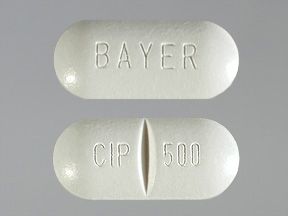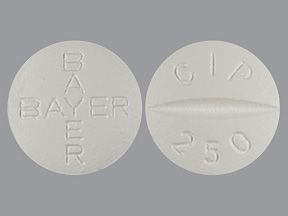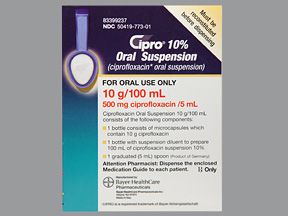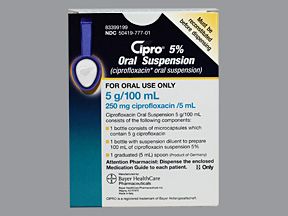Key Takeaways
- Cipro (ciprofloxacin) is a prescription antibiotic used to treat various bacterial infections in adults and some children. The prescribed dosage for Cipro may depend on the condition it’s being used to treat and other factors.
- The typical adult dosage for a urinary tract infection (UTI) is 250 to 500 mg every 12 hours for 7 to 14 days. The typical child dosage for UTI is based on body weight and is taken every 12 hours for 10 to 21 days.
- Cipro is available in two oral forms: tablet and liquid suspension.
Cipro (ciprofloxacin) is used for treating several types of bacterial infections in adults, including UTI, pneumonia, plague, and anthrax.
Doctors may prescribe Cipro for some children as a treatment for a complicated UTI or kidney infection. It may also be used to treat plague and anthrax in children.
The active ingredient in Cipro is ciprofloxacin. Cipro is a type of antibiotic called a fluoroquinolone.
This article describes the dosages of Cipro, as well as its strengths and how to take it. To learn more about Cipro, including its side effects and uses, see this in-depth Cipro article.
Cipro images
The following information describes dosages that are commonly given or recommended for Cipro. Your dosage will depend on the kind of infection you have. But be sure to take the dosage your doctor prescribes for you. They’ll determine the best dosage to fit your needs. In some cases, doctors may adjust your dosage from those shown here.
Note: Cipro only treats infections caused by certain kinds of bacteria. Your doctor may stop Cipro and change your prescription to a different antibiotic if they think your infection isn’t responding to Cipro.
What are the forms of Cipro?
Cipro comes in two forms, and both are swallowed:
- tablet
- liquid suspension (a type of liquid mixture)
What strengths does Cipro come in?
Cipro tablets come in two strengths:
- 250 milligrams (mg)
- 500 mg
The liquid suspension comes as microcapsules that your pharmacist will mix with a liquid. When mixed, the strengths are:
- 250 milligrams (mg) per 5 milliliters (mL)
- 500 mg per 5 mL
Cipro is approved to treat certain bacterial infections, including UTIs, some sexually transmitted infections (STIs), and more.
Cipro dosage for UTI
To treat a UTI in adults, the typical dosage of Cipro is 250 to 500 mg every 12 hours, continued for 7 to 14 days.
UTIs in females are sometimes treated differently. If the infection is in the bladder and is caused by a certain kind of bacteria, you may be prescribed a dosage of 250 mg every 12 hours for only 3 days. But it’s important to note that Cipro is only used to treat uncomplicated bladder infections (a bladder infection in an otherwise healthy female who isn’t at high risk of having a UTI) when no other treatment options are available. To learn more, see the previous “Boxed warnings” section.
Note: The use of binary terms such as “male” and “female” or “men” and “women” in this article reflects the language of the sources we’ve used. Unless otherwise noted, it’s unclear whether the research we reference included participants with expansive gender identities.
Cipro dosage for other bacterial infections
The dosage of Cipro taken for other bacterial infections in adults depends on the type of infection. The following table lists the dosages and lengths of treatments for various infections.
| Type of infection | Dosage | Length of treatment |
|---|---|---|
| abdominal infection | 500 mg every 12 hours | 7 to 14 days |
| anthrax | 500 mg every 12 hours | 60 days |
| bone or joint infection | 500 to 750 mg every 12 hours | 4 to 8 weeks |
| gonorrhea | 250 mg single dose | — |
| infectious diarrhea | 500 mg every 12 hours | 5 to 7 days |
| lower respiratory infection such as pneumonia or bronchitis | 500 to 750 mg every 12 hours | 7 to 14 days |
| plague | 500 to 750 mg every 12 hours | 14 days |
| prostate infection | 500 mg every 12 hours | 28 days |
| sinus infection | 500 mg every 12 hours | 10 days |
| skin infection | 500 to 750 mg every 12 hours | 7 to 14 days |
| typhoid | 500 mg every 12 hours | 10 days |
Optum Now is owned by RVO Health. By clicking on this link, we may receive a commission. Learn more.
The dosage of Cipro for children depends on the type of infection being treated and the child’s weight. The following table lists the dosages of Cipro used in children to treat specific infections. Dosages are listed in mg of Cipro per kilogram (kg) of body weight, which the doctor will calculate. For reference, 1 kg is about 2.2 pounds (lb).
| Type of infection | Dosage | Length of treatment | Maximum dose |
|---|---|---|---|
| anthrax | 15 mg/kg every 12 hours | 60 days | 500 mg |
| complicated UTI | 10 to 20 mg/kg every 12 hours | 10 to 21 days | 750 mg |
| kidney infection | 10 to 20 mg/kg every 12 hours | 10 to 21 days | 750 mg |
| plague | 15 mg/kg every 8 to 12 hours | 14 days | 500 mg |
If you have questions about Cipro dosages for children, talk with your child’s doctor or pharmacist.
Here are answers to some commonly asked questions about Cipro’s dosage.
How many days will I take my Cipro dose for a UTI? Is there a 3-day dosing schedule?
Cipro is usually prescribed for 7 to 14 days to treat a UTI but it may be prescribed for only 3 days in certain situations.
Doctors may prescribe a 3-day dosing schedule for uncomplicated bladder infections in adult females if no other treatment options are available. (A bladder infection is a type of UTI.) See the “Boxed warnings” section for details.
When deciding how long you should take Cipro to treat your UTI, your doctor will consider:
- the severity of your infection
- the infection’s location
- the type of bacteria causing the UTI
- your sex assigned at birth
Children with a kidney infection or complicated UTI usually take Cipro for 10 to 21 days.
Is the pediatric dosage of Cipro based on body weight?
Yes, the dosage of Cipro for children is based on body weight up to a maximum dosage. The dosage also depends on the kind of infection being treated.
Your child’s doctor will calculate their dose. If the calculated dose is higher than the maximum dose, your child’s doctor will prescribe the maximum dose.
If you have questions about your child’s Cipro dosage, talk with their doctor.
What if I miss a dose of Cipro?
If you miss a dose of Cipro, take it as soon as you remember. But you should not take the missed dose if you’re within 6 hours of your next scheduled dose.
If your next scheduled dose is within 6 hours, skip the missed dose and take your next dose at its regularly scheduled time. Then continue taking Cipro as prescribed by your doctor. You should not take a double dose of Cipro to make up for a missed dose. Doing so may increase your risk of side effects.
You can talk with your doctor or pharmacist if you’re unsure when to take Cipro after missing a dose or have other questions. And if you need help remembering to take your dose of Cipro on time, try using a medication reminder. This can include setting an alarm or downloading a reminder app on your phone.
The dosage of Cipro you’re prescribed may depend on several factors. These include:
- the type and severity of the infection you’re taking the drug to treat
- the type of bacteria causing the infection, if known
- your age and weight
- how well your kidneys work
Dosage adjustments
Cipro is primarily removed from your body by your kidneys. If you have kidney disease, your doctor may lower your dose or increase the amount of time between doses.
Cipro tablets and liquid suspension are both swallowed.
You can take either form with or without food. However, you should not take Cipro with dairy products (such as milk or yogurt) or calcium-fortified juices, unless those foods are part of a larger meal. Taking Cipro with foods high in calcium decreases the amount of Cipro released into your body.
If you’re taking Cipro tablets, you may split them in half. But do not crush or chew the tablets. If you have difficulty swallowing tablets, check out these tips for taking pills. You can also talk with your doctor to check whether another form of Cipro might be an option for you.
If you’re prescribed the liquid suspension, your pharmacist will prepare it for you at the pharmacy. It consists of Cipro microcapsules in a liquid.
Before taking each dose of Cipro liquid suspension, shake the container well for approximately 15 seconds. Use the teaspoon provided to measure your dose. You should swallow the Cipro liquid suspension whole. Do not chew on the microcapsules, as this may release the medication too quickly and increase your risk of side effects.
Is Cipro given long term?
No, Cipro is usually a short-term treatment. Depending on the type of infection you’re taking Cipro to treat, you may take it for up to 60 days.
Accessible drug containers and labels
If you find it hard to read the prescription label on your medication, tell your doctor or pharmacist. Some pharmacies provide medication labels that:
- have large print or use braille
- feature a code you can scan with a smartphone to change the text to audio
Your doctor or pharmacist may be able to recommend pharmacies that offer these accessibility features if your current pharmacy doesn’t.
If you have difficulty opening medication bottles, let your pharmacist know. They may be able to supply Cipro in an easy-open container. They may also have tips to help make it simpler to open the drug’s container.
Do not take more Cipro than your doctor prescribes, as this can lead to serious side effects, such as kidney failure.
What to do in case you take too much Cipro
Call your doctor right away if you think you’ve taken too much Cipro. You can also call 800-222-1222 to reach America’s Poison Centers or use its online resource. But if you have severe symptoms, immediately call 911 (or your local emergency number) or go to the nearest emergency room.
Disclaimer: Healthline has made every effort to make certain that all information is factually correct, comprehensive, and up to date. However, this article should not be used as a substitute for the knowledge and expertise of a licensed healthcare professional. You should always consult your doctor or another healthcare professional before taking any medication. The drug information contained herein is subject to change and is not intended to cover all possible uses, directions, precautions, warnings, drug interactions, allergic reactions, or adverse effects. The absence of warnings or other information for a given drug does not indicate that the drug or drug combination is safe, effective, or appropriate for all patients or all specific uses.








